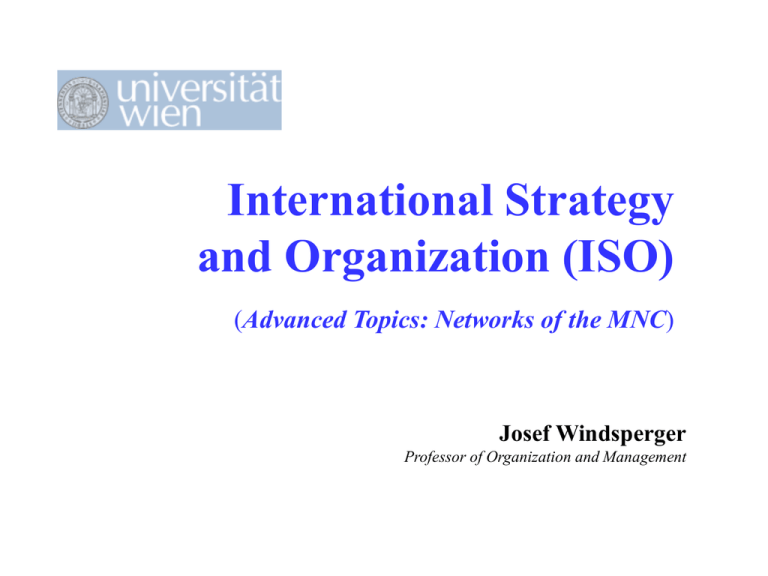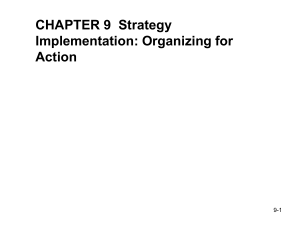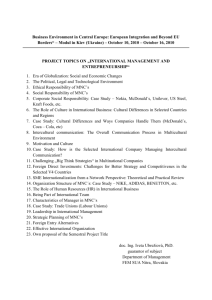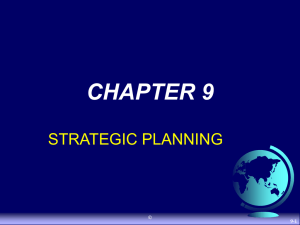ISO2006partI
advertisement

International Strategy and Organization (ISO) (Advanced Topics: Networks of the MNC) Josef Windsperger Professor of Organization and Management International Strategy and Organization (ISO) (Advanced Topics: Networks of the MNC) Lecturer: Josef Windsperger E-mail: Homepage: josef.windsperger@univie.ac.at www.univie.ac.at/IM Phone: 00431-4277-38180 The course consists of two parts (Hs. 4): A.Lectures on ISO: 7. 4. , 28. 4., 5.5. 2006, 9.00 – 13.00 (course material is published on the web page: www.univie.ac.at/im under ‘Lehrveranstaltungen’). B.Case Studies on ISO: 12.5. (9-13.00) , 19. 5. (9 – 14.30) and 16.6. 2006 (9.00 – 13.00) and 17. 6. 2006 (9 – 13.00) The public lectures are on Friday (11.00 – 12.30); for details see www.univie.ac.at/im. 1. Public Lecture: May 5, 2006: 11.00, Hs. 4 Headquarter-Advantages of Vienna in CEE (Mag. Thumser, CEO Henkel Austria 2. Public Lecture: May 19, 2006: 11.00, Hs. 4 International Market Entry through Franchising (Mag. W.Martius, Synchon International) 3 Content Part I 1 MNC as Global Network: Existence and Evolution 1.1 Product Life Cycle Theory 1.2 Transaction Cost Theory 1.3 Eclectic Theory 1.4 Network Approach 2 Culture, Strategy and Organization of the MNC 2.1 Country and Organization Culture 2.2 Strategy and Organization Design 3. Theoretical Foundations of Networks 3.1 Economic Approaches of Networks 3.2 Efficiency of Network Design 3.3 Networks, Trust and IT Content Part II 4 Design und Management of Networks of the MNC 4.1 International Licensing 4.2 International Strategic Alliances and Joint Ventures 4.3 International Franchising-Networks 4.4 Networks and M&As 4.5 Market Entry through Networks: An Integrative Approach 4.6 Internationalization through Countertrade 4.7 International Clusters 5 Organization Design of the MNC of the Future 1 MNC als Global Network 1.1 Product Life Cycle Theory Vernon (1966): Extension of the product life cycle view to explain the internationalization of the firm. 1.2 Transaction Cost Theory Transaction costs = » costs of using the price mechanism (Coase 1937) Search costs Planning period: Ex ante costs Information costs Costs of decision making Negotiation costs Transaction Costs Contract execution period: Ex post costs Monitoring or control costs Contract execution costs Adjustement costs Transaction Cost Theory O. E. Williamson (1975) Atmosphere Bounded Rationality Uncertainty/Complexity ‚Information Impactedness‘ Opportunism Transaction Specifity Market and Hierarchy CC Transaction costs Organizational costs (Setup-costs) Degree of organization Quasi-Rents, Specific Investments and Hold-up g BA A B g AB D g AC g BD C B‘s profit with A: gBA A‘s profit with B: gAB A‘s quasi-rent: QRAB = (gAB – gAC) B‘s quasi-rent: QRBA = (gBA – gBD) Quasi-rent of A (QRBA) = HOLD-UP Potential of B (HB) Transaction Cost Theory of the MNC from Teece 1.3 Dunning‘s Eclectic Theory 1.4 Network Approach Degree of the Internationalization of the Market Degree of the internationalisation 0f the firm Low High Low “The Early Starter” “The Late Starter” High “The Lonely International” “The International Among Others” 2 Culture, Strategy and Organization of MNC 2.1 Country and Organization Culture •“Culture is the collective programming of the mind.” Geert Hofstede Hofstede Individualism/collectivism Masculinity/femininity Uncertainty avoidance Power distance Power Distance Individualism beschreibt beschreibt The extent to which people tollerate unequal distribution of power in economy and society. The degree of integration of individuals in groups Individualism: Individual values, individual responsibility, goal orientation Collectivism: Group values, loyal behavior, common responsibility Masculinity Uncertainty Avoidance beschreibt beschreibt How tolerant are the people concerning new and unstructured situations? How strong are masculin values (for instance achievement, success, money) compared to feminin values (security, life quality, social contact)? high UA: Many Rules, regulations and legal norms to minimize risk Model of Hofstede Country Comparison Uncertainty Avoidance Formalization low Village market (nordic) -Decentralized, flexible -Coordination through personal and informal communication Well-oiled machine (Germanic) -Decentralized decision making -Strong role of experts -Coordination through rules and routines Family or tribe (Asiatic) -Centralized decision making -Loyal, personal relationships -Sozial control (clan control) Traditional bureaucracy „Pyramid of people“ (Latin) -Centralized decision making -Central personal coordination -Informal relationships high low Hierarchy high Power distance Model of Trompenaars: Country and Organization Culture Decentralization Incubator Guided Missile Goal Orientation Persons (formal) (informal) Eiffel Tower Family Centralization 2.2 Strategy und Organization design of the MNC 2.2.1 Strategies of the MNC What is a competitive advantage? Sustainable cost and/or revenue advantages compared to the best competitor Ressources Capabilities Strategy Industry structure I. Strategic Approaches: Porter‘s Model Competitive advantage through low costs and differentiation monopolistic Rents Low-cost, differentiation and focus strategy Resource-based Approach (Barney, Wernerfelt) Strategy Strategic Rents Competitive advantage Competencies Resources Change of the resource bundle Tangible and intangible resources II. International Strategies: Perlmutter Ethnocentric Strategy Polycentric Strategy Geocentric Strategy Regiocentric Strategy Perlmutter‘s Model Bartlett/Ghoshal-Model high Global Strategy Cost pressures International Strategy Transnational Strategy Multinational Strategy low high low Pressure for local responsiveness 2.2.2 Strategy and Organisation Design Chandler (1962): „Structure follows Strategy“ Matrix structure Product-/geographic Structure Differentiation strategy Functional Structur Low-cost strategy Barlett/Ghoshal-Model International Division CEO HR Finance R&D Int. Division Europe Middle East Brazil Staff Global Geographic Structure CEO Pacific Division European Division Latin American Division Corporate Staff Long Term Planning Product Coordination ABB Comparison Global Heterarchy (Hedlund) Transnational Organization (Bartlett/Ghoshal) Country competence centers Local and global advantages Decentralisation of decision making Centralization of control IT-enabled strategy Organization culture as clan control 3. Theoretical Foundations of Networks Hierarchy Stable Network Internal Network One Firm Dynamic Network Several Firms External Networks Joint Venture High Consortium Countertrad e Interaction Level Franchising Cluster CrossLicensing Licensing Cooperation low Competition Cooperation Cooperation Propensity Keiretsu Other Financial Institutions Banks Insurance Companies Internal Network Trading Companies Production Companies External Network Subcontractors Equity: Finance: Goods: A B C D F Consortium: NewPC-Consortium in Taiwan 3. 1 Economic Theories of Networks Transaction Cost Theory Property Rights-Theory Strategic or Resource-based Theory Transaction Cost Theory TC Market Network Hierarchy Spezifity S1 S2 S3 Property Rights-Theory a. the right to use the good b. the right to change the good c. the right to capture the profit or to bear the loss d. the right to sell the good and to receive the liquidation value a + b = Residual decision rights c + d = Residual income or ownership rights Contractibility (due to intangibility) of assets determines the structure of residual rights Example: Franchising-Network Intangible assets of the franchisor: Brand name assets, system-specific know-how Intangible assets of the franchisee: Outlet-specific knowledge ao and a1 are tangible – market coordination ao is intangible, a1 is tangible – internal coordination ao and a1 are intangible – network coordination Resource-based Theory Strategic Rents (SR) (Schumpeterian and Ricaridian Rents) Organizational Capabilities Resources Resource Characteristics Intangible, tangible resources and organizational capabilities Heterogenity Imitability Substitutability Firm specifity + Contractibility 3.2. Organizational Efficiency of Networks A) Transaction Costs ‚Organization for efficient exploitation of knowledge differences‘ (knowledge exploitation‘ – March 1991) Coordination efficiency: coordination costs Motivations efficiency: motivation costs (Agency costs) Efficient Organization Design Motivation Costs (Agency Costs) Coordination Costs Centralization Degree of Delegation B) Criteria of the Resource-based Theory ‚Organization design for efficient knowledge creation‘ (‚knowledge exploration‘ – March 1991) Strategic rents (SR): Schumpeterian und Ricardian Rents - Schumpeterian rents due to dynamic capabilities - Ricardianian rents due to heterogenity of resources and capabilities Organisational Efficiency: SR – TC 3.3 Networks, Trust and IT g BA A B g AB D g AC g BD C B‘s Reputation capital: RB A‘s Reputation capital: RA A‘s Quasi-Rents: QRAB = (gAB – gAC) B‘s Quasi-Rents: QRBA = (gBA – gBD) Quasi-Rents of A (QRAB) + reputation capital of A (RA) A> H cooperative behavior A< H opportunistic behavior Strategic Rents, Hold-up and Reputation g GMFB FB GM g FBGM D g GMD g FBC C GM‘s strategic rents under market coordination: SRGMFB GM‘s strategic rents under internal coordination: SRGMGM GM‘s SR-advantage under market coordination: SRGM = (SRGMFB – SRGMGM) Quasi-Rents of GM (QRGM) + strategic > HGM - cooperative rent advantage under market < HGM - opportunistic coordination of GM ( SRGM) (QRGM + SRGM + RGM - HGM) > 0 is „self-enforcing range“ (Klein 1995) Transaction Costs and IT Specifity Transaction Costs Communication Information Processing Move to the Network TC Market Network Hierarchy Specifity S1 S2 S3





